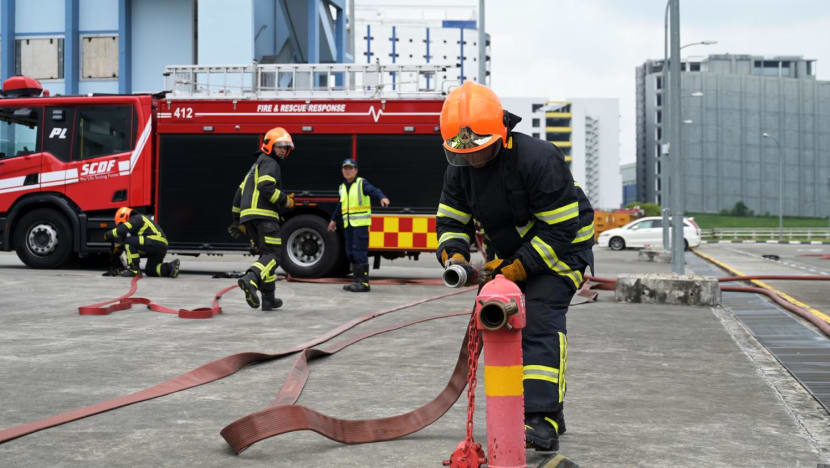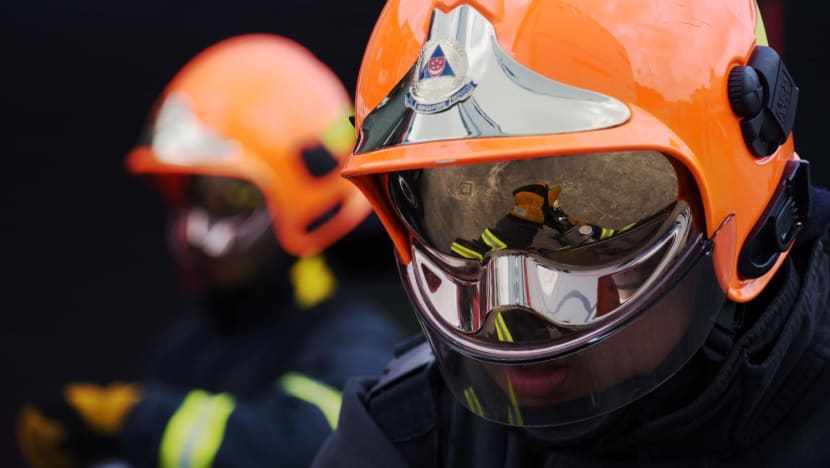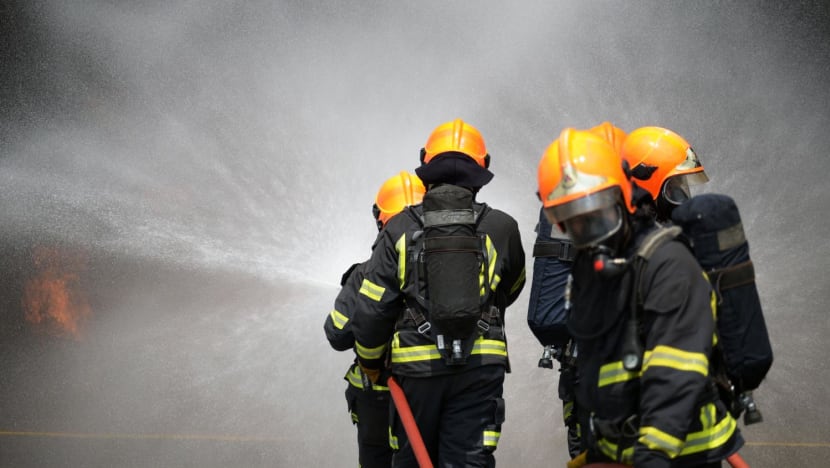Fighting flames, taking tests: What trainees undergo as part of SCDF's Firefighter Course
SCDF trains about 500 full-time NSFs as firefighters annually and prior to their deployment in the field, eligible NSFs are required to undergo the 12-week Firefighter Course at the Civil Defence Academy.
SINGAPORE: In a dark corridor within the lower deck of a commercial ship, a fire breaks out.
The flames spread quickly overhead due to the rapid heat build up in the confined space, resulting in a phenomenon known as flashover.
But on hand is a team of firefighters from the Singapore Civil Defence Force (SCDF). Crouched low, they work in tandem to fight the flames.
After a brief battle, they eventually manage to push the fire back, and can proceed further. Crisis averted.
A STRUCTURED PROGRAMME
While the flames are real, the heat is fierce and the conditions are difficult, the environment is a carefully controlled one.
This is after all one of the many training scenarios that SCDF full-time national servicemen (NSFs) undergo as part of their 12-week Firefighter Course (FFC).
Trainees are aboard the ORCA, a training simulator that replicates a ship’s internal structures and compartments, where they go through various marine firefighting and rescue scenarios.
The intensity of the fire controlled is by an operator, cameras are mounted to keep a close eye on proceedings, and the firefighters are accompanied by a Conducting Officer and a Safety Officer.
"The Firefighter Course is a structured and comprehensive programme designed to equip all our trainees with operational skillsets necessary of a modern firefighter," Civil Defence Academy director and Assistant Commissioner Alan Chow told reporters during a media visit to the Home Team Tactical Centre on Tuesday (Jan 10).
"We make use of 'live' fire simulators as well, to make sure that our trainees get the the full experience of live firefighting environments itself, akin to real fire scenarios."

Speaking in Parliament on Monday (Jan 9), Minister of State for the Ministry of Home Affairs Muhammad Faishal Ibrahim had also touched on training which NSFs undergo during their time in the SCDF.
He was responding to questions from MP Murali Pillai (PAP-Bukit Batok) and MP Gerald Giam (WP-Aljunied) on the Henderson Road blaze last month.
A 19-year-old full-time national serviceman (NSF), Edward H Go, fell unconscious while fighting the fire and died in hospital. He was the first firefighter to have lost his life during an operation by the SCDF.
SGT1 Go was accorded a ceremonial funeral on Dec 13 and posthumously promoted from the rank of corporal.
Associate Professor Faishal said that a fire engine accessway leading to the Henderson Road block where a fire broke out last month was blocked by a funeral wake tent, leading to a delay in firefighters' response to the blaze.
TWO DIFFERENT PHASES
SCDF trains about 500 full-time NSFs as firefighters annually and prior to their deployment in the field, eligible NSFs are required to undergo the FFC at the Civil Defence Academy, it said in a media factsheet.
Only NSFs who are certified to be medically fit and be of 'A', 'B1' or 'B2' Physical Employment Standards (PES) are eligible to be selected to join the FFC as a trainee.
There are other physical requirements which include a minimum height of 1.6m, a minimum weight of 50kg and eyesight not exceeding 1000 degrees.
Those who have physical conditions such as asthma, a Body Mass Index less than 18 or a history of severe fractures will also not be eligible.
In addition, a trainee's Individual Physical Proficiency Test (IPPT) result during their Basic Rescue Training phase will also be taken into consideration.
Those who are assessed to have psychological or well-being issues which may impact their operational performance will be highlighted for exclusion from the FFC.

The FFC consists of two main phases, the first of which involves four weeks of Basic Firefighting Training.
During this period, trainees will learn about firefighting fundamentals, basic firemanship as well as learning how to use the Self-Contained Breathing Apparatus (SCBA), which firefighters use when responding to fires.
The second phase will involve firefighting training, which includes tactical and specialised skills. Trainees learn about urban search and rescue, as well as how to respond to a hazardous materials incident among other things.
"No amount of training itself will be a substitute for experience, but realistic training itself will help with dealing with actual situations on the ground," said AC Chow.
The FFC includes both theoretical and practical components, and a series of proficiency and certification tests.
These include the IPPT, Breathing Apparatus Proficiency Test (BAPT), Hazmat Responder Certification Test, Practical Firemanship Skills Assessment, and a written test on basic firemanship, rescue and equipment knowledge.
The BAPT, in particular, helps to assess the operational fitness of firefighters. It comprises six elements - the donning of the breathing apparatus (BA), ladder climbing, stair climbing, fire hose carry, casualty carry and the BA maze, which is a search and rescue obstacle course with configurable modules.
With training conditions simulating actual operational conditions, personal protective equipment and other equipment used, such as nozzles, are similar to those deployed at the frontline.
The FFC has also been audited and certified to conform with two International Organization for Standardization (ISO) standards.
An annual audit is also conducted at the Civil Defence Academy with a key component aimed at assessing if training safety regulations are adhered to.
After being deployed to the frontline at fire stations, officers, including NSFs, undergo drills and exercises during their shifts to familarise them with their respective roles and functions operating as part of a first response crew.
They also undergo certification and proficiency tests on an annual basis, said AC Chow.

FACING THE HEAT
"So far our trainings are tough, physically and mentally, but at the same time, we are training for a reason, training as a firefighter, so of course the training has to be tough," said Private John Villaneuva, who is close to completing his FFC.
When dealing with "live" simulations, the heat can be challenging to deal with, added Private Allenson Tan.
"When it is hot, sometimes, you feel very tired and in your mind, you just want to give up, and want to go out and drink water. The BA set that we are wearing, the air we breathe is very dry for our throat, and it gets hard to breathe and hard to talk," he explained.
PTE Tan recalled how he had wanted to give up when going through the BA maze for the first time. However, seeing the determination of his section mates inspired him to push on, he added.
Both PTEs Villaneuva and Tan believe that their training has provided them with the foundation to fight fires in the real world.
"I don't think we're very worried of what we are going to face outside because it (experience) comes with training. When you get more experience, it becomes muscle memory," said PTE Villaneuva.
"Each time you turn up for a fire, you know what to do. It becomes automatic when you encounter it."














